FROM PARTICIPATION TO IMMERSION
A few decades ago, the art utopia consisted of incorporating the viewer into the work, either physically or sensorially. Frank Popper called these practices with the term "participation art".
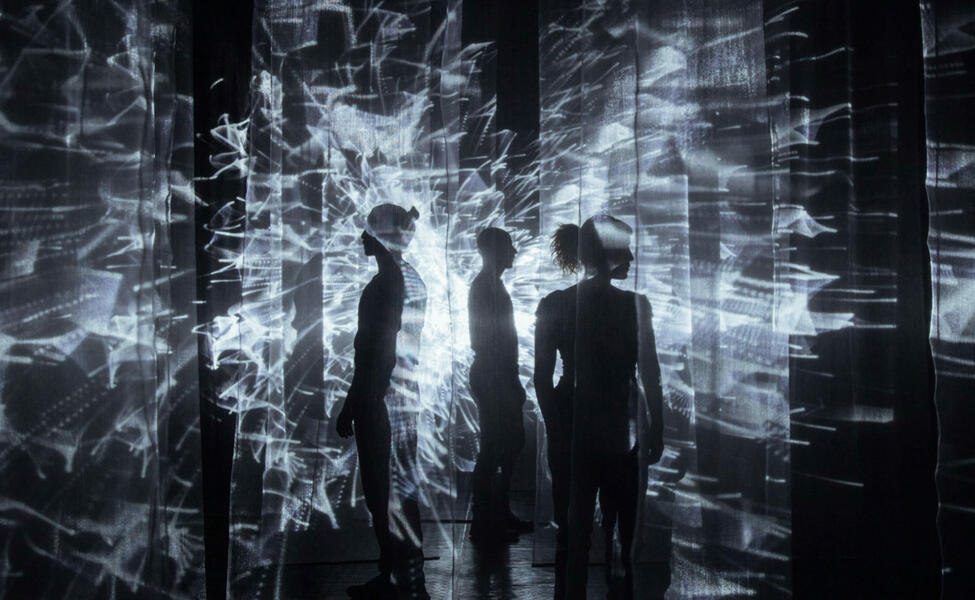
In Rio de Janeiro, Helio Oiticica conceived his parangolés as a vehicle for popular and aesthetic interaction; in Caracas and London Diego Barboza mobilized dozens of people with his poemas de acción, in Valparaíso Manuel Casanueva Carrasco and his students developed playful tournaments of body and space interaction; in Paris Julio Le Parc, García-Rossi, Hugo Demarco, F. Morellet, Denise René, Francisco Sobrino Ochoa, J. Stein and Yvaral, grouped around the Grav (Groupe de Recherche d'Art Visuel), invoked the dynamization of space public with optical, physical and tactile gadgets; while Carlos Cruz-Diez installed his chromosaturation booths in the streets so that passers-by could color themselves. A few stimuli and the presence of several people were enough to trigger a shared experience. So it was about "being together", in the midst of situations aimed at personal and artistic coexistence.
Of course, many other visual creation practices took advantage of this premise, especially Allan Kaprow's mass happenings in the United States, the Fluxus actions in Europe and North America, and the environmental activism and social sculpture campaigns carried out by Joseph Beuys in Germany. . In all these cases the incentive was also "to be together" and to erase the limits between art and life.
Over time, advances in digital technology have led to the appearance of so-called "immersive art", a modality that inherits the scenographic format of video installations but has evolved towards a multisensory experience, defying the boundaries between reality and simulation. through monumental projections, sound and the combination of video mapping techniques, augmented reality, virtual reality and 3D.
The core of the issue is to promote active behavior of the viewer and make him the protagonist of the artistic experience. However, many of the immersive practices often decline towards an exclusively playful approach aimed at entertainment and not the cultivation of aesthetic sensibility, an issue that is especially visible in the immersive recreation of pictorial works where the plastic qualities disappear to be replaced by a virtual faccimil from the original scene. The other issue is that immersive art amplifies the sensory link with the work but weakens the link with the environment.
Two of the most influential thinkers of our time have come to strikingly similar conclusions, though by different routes. For Boris Groys “digital metadata creates an objectless aura”, while for Byung-Chul Han, in the “post-factual information” society, the digital order suppresses distances and replaces objects (including artistic ones) with “non-objects” stuff.
-
Helio Oiticica. Moradores do morro da Mangueira, no Rio de Janeiro, com Parangolés de Hélio Oiticica durante as filmagens de H.O., de Ivan Cardoso, 1979
-
Helio Oiticica. Moradores do morro da Mangueira, no Rio de Janeiro, com Parangolés de Hélio Oiticica durante as filmagens de H.O., de Ivan Cardoso, 1979
-
Joseph Beuys planta el primer árbol de la obra 7000 Eichen frente al Museo Fridericianum. Documenta 7, 16 de marzo de 1982
-
Yayoi Kusama, Aftermath of Obliteration of Eternity, 2009 Museum Fine Art Houston 2016
We could say that with immersive art the participation of the public reaches its full potential. And yet, the purpose of "being together" or "doing things together" has drifted into a way of "hallucinating together" in a parallel dimension where everyone is their own alter ego. In this sense, immersion consists of entering a world of "radical otherness" as Jean Baudrillard presciently maintained or of "actants", connected by a digital interface like the one described by Bruno Latour.
Both participatory art and immersive art have as a common premise the activation of the aesthetic experience through the senses. However, they start from different notions of the corporal and the face-to-face. The first supposes the "melee" in space; the second requires technological mediation and virtual contact. In both cases, a world without exteriority and a work without borders are prefigured.
In their Proposal for a place of activation (1963) the GRAV artists proposed a space without "images hanging on the walls, neither actors nor passive spectators, neither teachers nor students, just one or two things and people with time to share". In 2001, almost four decades later, the Japanese immersive experiences collective TeamLaB moved the process of participatory interaction from the physical to the technological, stating that "Digital art has the ability to change the relationships between people who are present within a same space."
There is here an undoubted genealogy where the work is completed with the active presence of the viewer; only that the supports and procedures to achieve such purpose have changed drastically. The link is now less capillary and the coexistence more remote. The time will come when there will no longer be a place for the meeting, nor subjects to interact; just sleepwalking avatars immersed in a world of pure sensations. Then everything will be the same and art will have the undifferentiated "aura" of "non-things".
Related Topics
May interest you
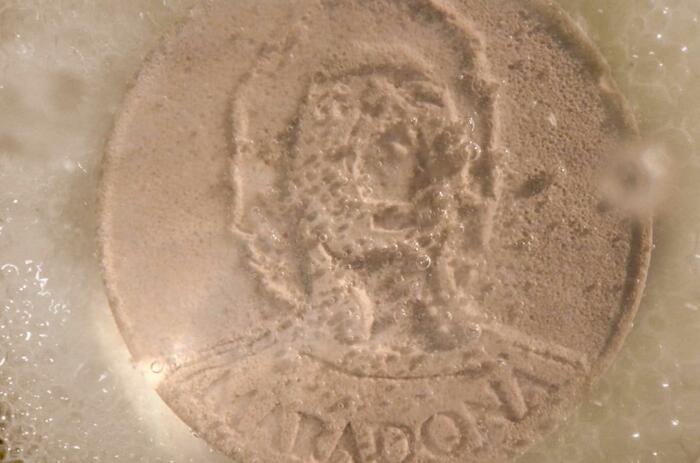
CLAUDIO CORREA: OVERCOMING A RESISTANCE

CLAUDIO CORREA: OVERCOMING A RESISTANCE

With the curatorship of Félix Suazo, Pinta Miami 2021 becomes a scenario for immersive and thought provoking installations. The aim of Pinta’s section Special Projects is to accentuate the individuality and artistry of contemporary artists who, through their works and installations, bring to life the concerns and possibilities of the near future.
THE BEAUTY OF DANGER AS STIMULUS – NAN GONZÁLEZ IN PINTA CONCEPT
With the curatorship of Félix Suazo, Pinta Miami 2021 becomes a scenario for immersive and thought provoking installations. The aim of Pinta’s section Special Projects is to accentuate the individuality and artistry of contemporary artists who, through their works and installations, bring to life the concerns and possibilities of the near future.

Recently, Richard Garet, a multimedia artist based primarily in New York City, opened a solo exhibition titled “Frame Compositions” with 1stDibs NFT marketplace. The eponymous show exhibits 29 vibrant NFT works and explores the relationship between color, light, surface and form. Garet’s practice encompasses sound installations, performance, computer applications and other mediums. Adhering to strict parameters, he creates compositions by carefully selecting high-definition 1080x1080-pixel square frames one-by-one and then collating 60 per second using computer applications. Because each work contains 1800 frames squeezed into a 30 second time period, the eye can no longer identify individual frames, thus, creating moving images.
RICHARD GARET: FRAME COMPOSITIONS
Recently, Richard Garet, a multimedia artist based primarily in New York City, opened a solo exhibition titled “Frame Compositions” with 1stDibs NFT marketplace. The eponymous show exhibits 29 vibrant NFT works and explores the relationship between color, light, surface and form. Garet’s practice encompasses sound installations, performance, computer applications and other mediums. Adhering to strict parameters, he creates compositions by carefully selecting high-definition 1080x1080-pixel square frames one-by-one and then collating 60 per second using computer applications. Because each work contains 1800 frames squeezed into a 30 second time period, the eye can no longer identify individual frames, thus, creating moving images.
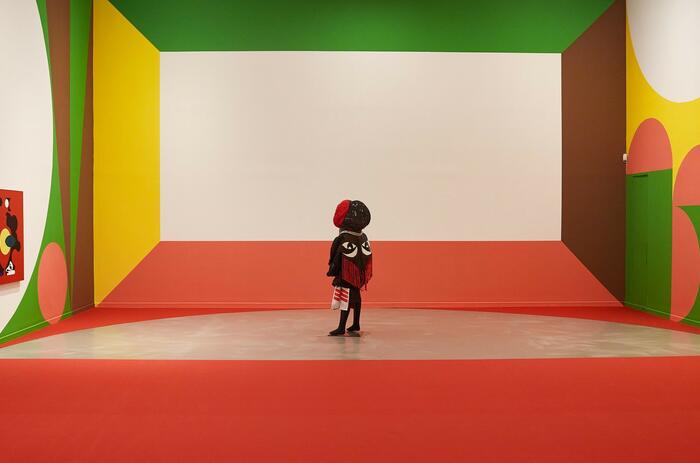
Fantastic Interior is made up of four scenes, interventions that take place throughout the year by four different artists, whose common thread is issues such as intimacy, self-care and the construction of subjectivity. Through the practice of these artists -Ad Minoliti, Marina González Guerreiro, Eva Kot'átková and Korakrit Arunanondchai-, the curator Rafa Barber Cortell invites us to think about the imaginary that has been created around the "inner world".
FANTASTIC INTERIOR AT THE CASA ENCENDIDA – MONTEMADRID FOUNDATION
Fantastic Interior is made up of four scenes, interventions that take place throughout the year by four different artists, whose common thread is issues such as intimacy, self-care and the construction of subjectivity. Through the practice of these artists -Ad Minoliti, Marina González Guerreiro, Eva Kot'átková and Korakrit Arunanondchai-, the curator Rafa Barber Cortell invites us to think about the imaginary that has been created around the "inner world".
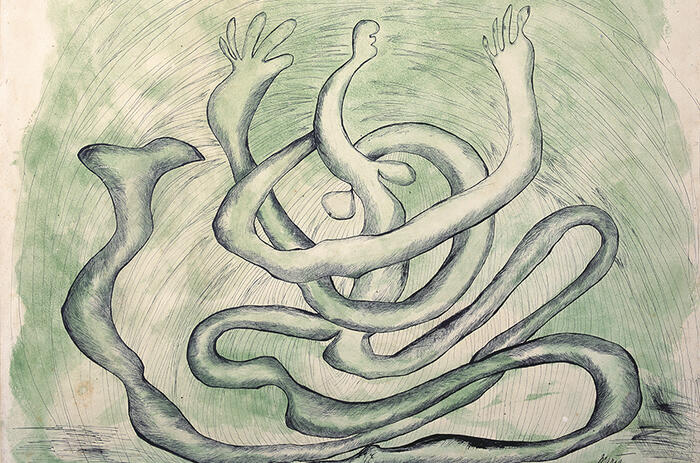
Reluctantly classified, with increasing complexity and interest, the work of Maria Martins (1894-1973) has yet to gain recognition in her native country. But a selection of some 50 pieces, on display in Rio de Janeiro through June, should help reposition the sculptor, draftswoman and engraver in the pantheon of leading Brazilian artists.
THE SURREALIST INTRANSIGENCE OF THE TROPICS – MARIA MARTINS: IMAGINARY DESIRE
Reluctantly classified, with increasing complexity and interest, the work of Maria Martins (1894-1973) has yet to gain recognition in her native country. But a selection of some 50 pieces, on display in Rio de Janeiro through June, should help reposition the sculptor, draftswoman and engraver in the pantheon of leading Brazilian artists.
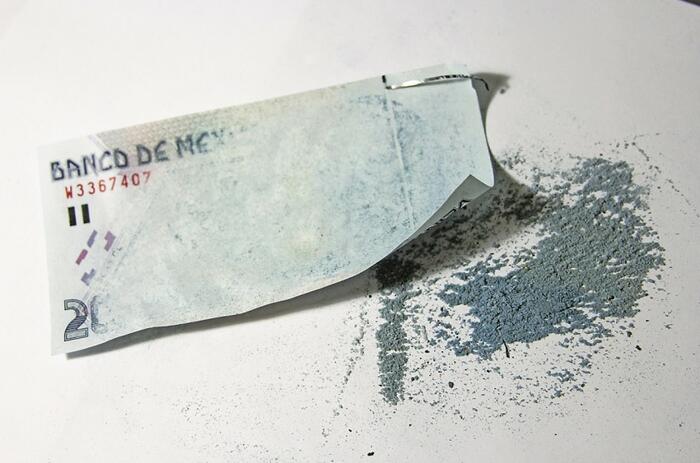
Collectors, investors and artists are fascinated by the promising profitability of NFTs. The phenomenon exploded with the succulent sale of a digital work by Beeple (Mike Winkelmann) in 2021 and since then it has generated a chain reaction whose consequences are still not entirely clear.
NFT, BLOCKCHAIN AND CRYPTOART: CHAIN REACTION
Collectors, investors and artists are fascinated by the promising profitability of NFTs. The phenomenon exploded with the succulent sale of a digital work by Beeple (Mike Winkelmann) in 2021 and since then it has generated a chain reaction whose consequences are still not entirely clear.
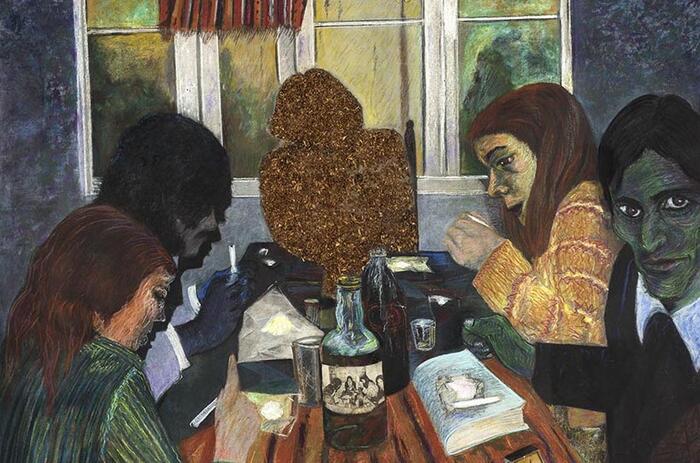
Regarding Artist in Residence, an exhibition by Fernando “Coco” Bedoya (Borja, 1952), at the Instituto Cultural Peruano Norteamericano (ICPNA) in Miraflores, Lima, Peru. Curated by Max Hernández Calvo, the exhibition is open until June 4, 2022.
ART, A HARD BONE TO CHEW
Regarding Artist in Residence, an exhibition by Fernando “Coco” Bedoya (Borja, 1952), at the Instituto Cultural Peruano Norteamericano (ICPNA) in Miraflores, Lima, Peru. Curated by Max Hernández Calvo, the exhibition is open until June 4, 2022.
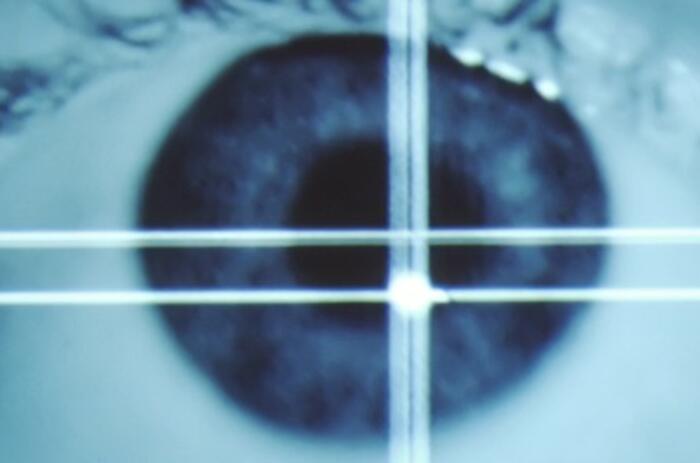
Before machines took over, many issues were resolved following an algorithmic principle with some logic and a little math. The originator of the idea was a Persian mathematician in the eleventh century. Later, the procedure became essential for science, everyday life and art. Basically, the algorithmic methods are in the patterns of Islamic art (see tessellation notation), in the Andean chakana and quipus of the Inca period, in the Renaissance perspective and in other representational devices of the pre-digital era.
ART AND ALGORITHMS. BEFORE (AND AFTER) MACHINES TOOK OVER
Before machines took over, many issues were resolved following an algorithmic principle with some logic and a little math. The originator of the idea was a Persian mathematician in the eleventh century. Later, the procedure became essential for science, everyday life and art. Basically, the algorithmic methods are in the patterns of Islamic art (see tessellation notation), in the Andean chakana and quipus of the Inca period, in the Renaissance perspective and in other representational devices of the pre-digital era.
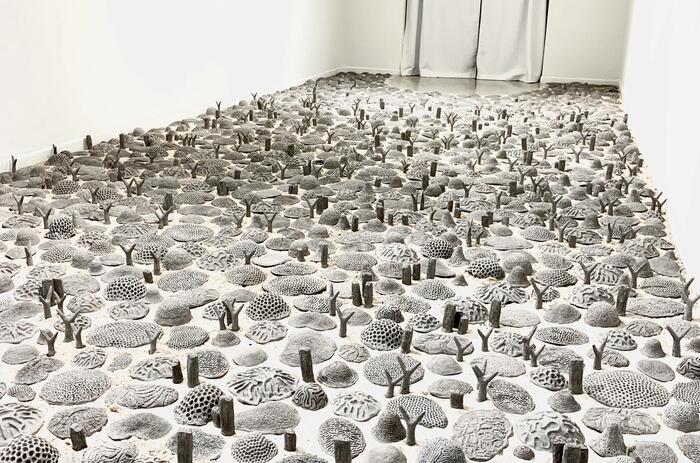
Review about the exhibition Into the Great Dying: (The Steps We Take), on view until June 2022
CLOSE ENCOUNTERS: ART AS A SOCIAL EXPERIMENT - BEATRIZ CHACHAMOVITS IN ART AND CULTURE CENTER, HOLLYWOOD, FLORIDA
Review about the exhibition Into the Great Dying: (The Steps We Take), on view until June 2022
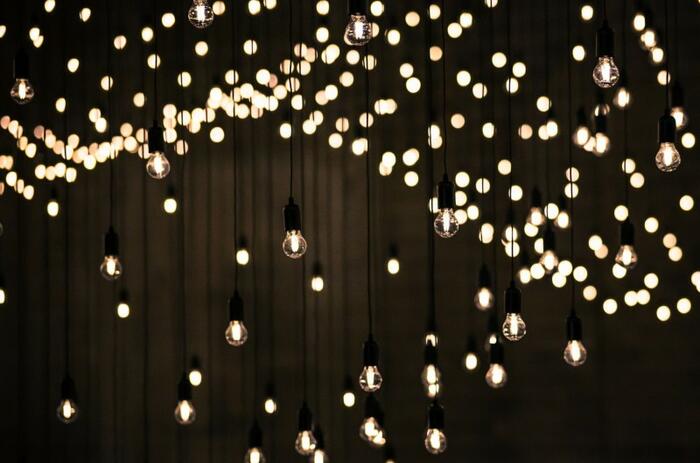
Presented by Superblue and BMW i, this art installation uses new technology to create an immersive chorus of 6,000 heartbeats. "Pulse Topology" will be presented in the foyer of Design Miami/ Basel from June 14 to 19.
RAFAEL LOZANO-HEMMER: "PULSE TOPOLOGY" AT DESIGN MIAMI/BASEL
Presented by Superblue and BMW i, this art installation uses new technology to create an immersive chorus of 6,000 heartbeats. "Pulse Topology" will be presented in the foyer of Design Miami/ Basel from June 14 to 19.
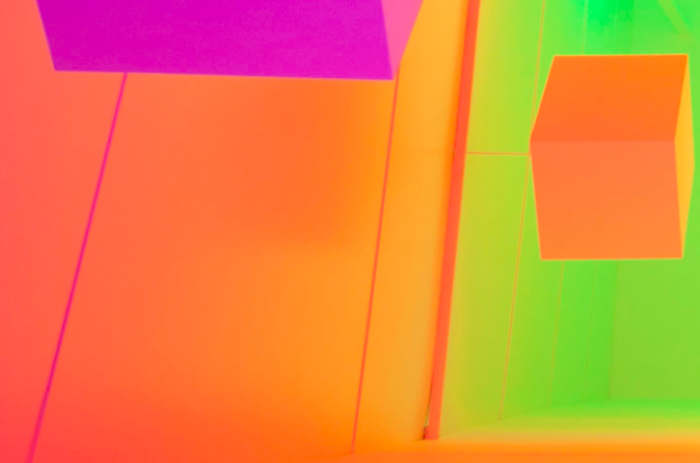
Acquired for PAMM’s collection in 2020 with funds provided by Jorge M. Pérez, Chromosaturation is an immersive environment that reimagines color as an embodied experience.
CARLOS CRUZ-DIEZ: CHROMOSATURATION AT PAMM
Acquired for PAMM’s collection in 2020 with funds provided by Jorge M. Pérez, Chromosaturation is an immersive environment that reimagines color as an embodied experience.
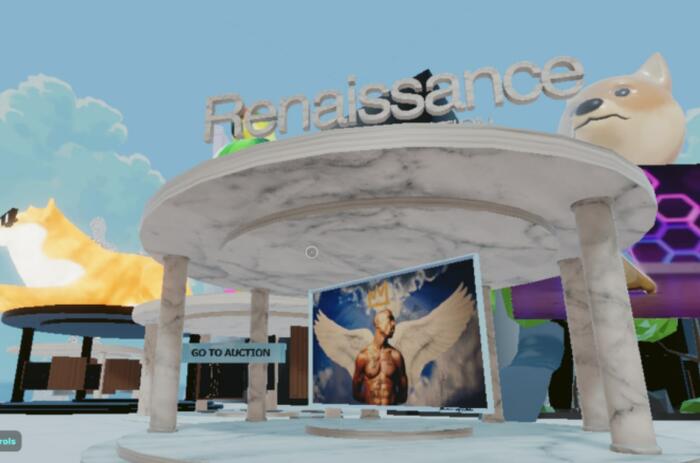
As a conceptual artist working in the crossroads of art, science, and technology, with a corporate past and a social communications baseline, I am deeply interested in the new digital ecosystem raised by blockchain technology, NFTs and the Metaverse, from a perspective that addresses this realm as a sociological phenomenon, as a new business field, and as another one of the many mediums I utilize to express my ideas.
NFTS AND METAVERSE: A CUBIST VIEW ON THE NEW DIGITAL ECOSYSTEM (PART 1)
As a conceptual artist working in the crossroads of art, science, and technology, with a corporate past and a social communications baseline, I am deeply interested in the new digital ecosystem raised by blockchain technology, NFTs and the Metaverse, from a perspective that addresses this realm as a sociological phenomenon, as a new business field, and as another one of the many mediums I utilize to express my ideas.
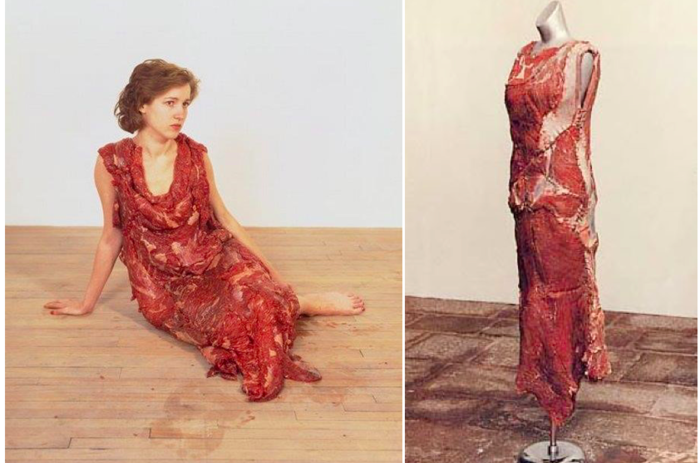
In 2010, the American singer, actress and producer Lady Gaga (New York, 1986) scandalized the audience at the MTV Awards by appearing at the gala in a dress made of beef, designed by Franc Fernández and styled by Nicola Formichetti. The press at the time reviewed the controversy triggered by the extravagant outfit, which for some was offensive and for others a declaration of creative freedom.
MEAT: NOTES ON SACRIFICE, POWER AND DESIRE
In 2010, the American singer, actress and producer Lady Gaga (New York, 1986) scandalized the audience at the MTV Awards by appearing at the gala in a dress made of beef, designed by Franc Fernández and styled by Nicola Formichetti. The press at the time reviewed the controversy triggered by the extravagant outfit, which for some was offensive and for others a declaration of creative freedom.

CLAUDIO CORREA: OVERCOMING A RESISTANCE

With the curatorship of Félix Suazo, Pinta Miami 2021 becomes a scenario for immersive and thought provoking installations. The aim of Pinta’s section Special Projects is to accentuate the individuality and artistry of contemporary artists who, through their works and installations, bring to life the concerns and possibilities of the near future.
THE BEAUTY OF DANGER AS STIMULUS – NAN GONZÁLEZ IN PINTA CONCEPT
With the curatorship of Félix Suazo, Pinta Miami 2021 becomes a scenario for immersive and thought provoking installations. The aim of Pinta’s section Special Projects is to accentuate the individuality and artistry of contemporary artists who, through their works and installations, bring to life the concerns and possibilities of the near future.

Recently, Richard Garet, a multimedia artist based primarily in New York City, opened a solo exhibition titled “Frame Compositions” with 1stDibs NFT marketplace. The eponymous show exhibits 29 vibrant NFT works and explores the relationship between color, light, surface and form. Garet’s practice encompasses sound installations, performance, computer applications and other mediums. Adhering to strict parameters, he creates compositions by carefully selecting high-definition 1080x1080-pixel square frames one-by-one and then collating 60 per second using computer applications. Because each work contains 1800 frames squeezed into a 30 second time period, the eye can no longer identify individual frames, thus, creating moving images.
RICHARD GARET: FRAME COMPOSITIONS
Recently, Richard Garet, a multimedia artist based primarily in New York City, opened a solo exhibition titled “Frame Compositions” with 1stDibs NFT marketplace. The eponymous show exhibits 29 vibrant NFT works and explores the relationship between color, light, surface and form. Garet’s practice encompasses sound installations, performance, computer applications and other mediums. Adhering to strict parameters, he creates compositions by carefully selecting high-definition 1080x1080-pixel square frames one-by-one and then collating 60 per second using computer applications. Because each work contains 1800 frames squeezed into a 30 second time period, the eye can no longer identify individual frames, thus, creating moving images.

Fantastic Interior is made up of four scenes, interventions that take place throughout the year by four different artists, whose common thread is issues such as intimacy, self-care and the construction of subjectivity. Through the practice of these artists -Ad Minoliti, Marina González Guerreiro, Eva Kot'átková and Korakrit Arunanondchai-, the curator Rafa Barber Cortell invites us to think about the imaginary that has been created around the "inner world".
FANTASTIC INTERIOR AT THE CASA ENCENDIDA – MONTEMADRID FOUNDATION
Fantastic Interior is made up of four scenes, interventions that take place throughout the year by four different artists, whose common thread is issues such as intimacy, self-care and the construction of subjectivity. Through the practice of these artists -Ad Minoliti, Marina González Guerreiro, Eva Kot'átková and Korakrit Arunanondchai-, the curator Rafa Barber Cortell invites us to think about the imaginary that has been created around the "inner world".

Reluctantly classified, with increasing complexity and interest, the work of Maria Martins (1894-1973) has yet to gain recognition in her native country. But a selection of some 50 pieces, on display in Rio de Janeiro through June, should help reposition the sculptor, draftswoman and engraver in the pantheon of leading Brazilian artists.
THE SURREALIST INTRANSIGENCE OF THE TROPICS – MARIA MARTINS: IMAGINARY DESIRE
Reluctantly classified, with increasing complexity and interest, the work of Maria Martins (1894-1973) has yet to gain recognition in her native country. But a selection of some 50 pieces, on display in Rio de Janeiro through June, should help reposition the sculptor, draftswoman and engraver in the pantheon of leading Brazilian artists.

Collectors, investors and artists are fascinated by the promising profitability of NFTs. The phenomenon exploded with the succulent sale of a digital work by Beeple (Mike Winkelmann) in 2021 and since then it has generated a chain reaction whose consequences are still not entirely clear.
NFT, BLOCKCHAIN AND CRYPTOART: CHAIN REACTION
Collectors, investors and artists are fascinated by the promising profitability of NFTs. The phenomenon exploded with the succulent sale of a digital work by Beeple (Mike Winkelmann) in 2021 and since then it has generated a chain reaction whose consequences are still not entirely clear.

Regarding Artist in Residence, an exhibition by Fernando “Coco” Bedoya (Borja, 1952), at the Instituto Cultural Peruano Norteamericano (ICPNA) in Miraflores, Lima, Peru. Curated by Max Hernández Calvo, the exhibition is open until June 4, 2022.
ART, A HARD BONE TO CHEW
Regarding Artist in Residence, an exhibition by Fernando “Coco” Bedoya (Borja, 1952), at the Instituto Cultural Peruano Norteamericano (ICPNA) in Miraflores, Lima, Peru. Curated by Max Hernández Calvo, the exhibition is open until June 4, 2022.

Before machines took over, many issues were resolved following an algorithmic principle with some logic and a little math. The originator of the idea was a Persian mathematician in the eleventh century. Later, the procedure became essential for science, everyday life and art. Basically, the algorithmic methods are in the patterns of Islamic art (see tessellation notation), in the Andean chakana and quipus of the Inca period, in the Renaissance perspective and in other representational devices of the pre-digital era.
ART AND ALGORITHMS. BEFORE (AND AFTER) MACHINES TOOK OVER
Before machines took over, many issues were resolved following an algorithmic principle with some logic and a little math. The originator of the idea was a Persian mathematician in the eleventh century. Later, the procedure became essential for science, everyday life and art. Basically, the algorithmic methods are in the patterns of Islamic art (see tessellation notation), in the Andean chakana and quipus of the Inca period, in the Renaissance perspective and in other representational devices of the pre-digital era.

Review about the exhibition Into the Great Dying: (The Steps We Take), on view until June 2022
CLOSE ENCOUNTERS: ART AS A SOCIAL EXPERIMENT - BEATRIZ CHACHAMOVITS IN ART AND CULTURE CENTER, HOLLYWOOD, FLORIDA
Review about the exhibition Into the Great Dying: (The Steps We Take), on view until June 2022

Presented by Superblue and BMW i, this art installation uses new technology to create an immersive chorus of 6,000 heartbeats. "Pulse Topology" will be presented in the foyer of Design Miami/ Basel from June 14 to 19.
RAFAEL LOZANO-HEMMER: "PULSE TOPOLOGY" AT DESIGN MIAMI/BASEL
Presented by Superblue and BMW i, this art installation uses new technology to create an immersive chorus of 6,000 heartbeats. "Pulse Topology" will be presented in the foyer of Design Miami/ Basel from June 14 to 19.

Acquired for PAMM’s collection in 2020 with funds provided by Jorge M. Pérez, Chromosaturation is an immersive environment that reimagines color as an embodied experience.
CARLOS CRUZ-DIEZ: CHROMOSATURATION AT PAMM
Acquired for PAMM’s collection in 2020 with funds provided by Jorge M. Pérez, Chromosaturation is an immersive environment that reimagines color as an embodied experience.

As a conceptual artist working in the crossroads of art, science, and technology, with a corporate past and a social communications baseline, I am deeply interested in the new digital ecosystem raised by blockchain technology, NFTs and the Metaverse, from a perspective that addresses this realm as a sociological phenomenon, as a new business field, and as another one of the many mediums I utilize to express my ideas.
NFTS AND METAVERSE: A CUBIST VIEW ON THE NEW DIGITAL ECOSYSTEM (PART 1)
As a conceptual artist working in the crossroads of art, science, and technology, with a corporate past and a social communications baseline, I am deeply interested in the new digital ecosystem raised by blockchain technology, NFTs and the Metaverse, from a perspective that addresses this realm as a sociological phenomenon, as a new business field, and as another one of the many mediums I utilize to express my ideas.

In 2010, the American singer, actress and producer Lady Gaga (New York, 1986) scandalized the audience at the MTV Awards by appearing at the gala in a dress made of beef, designed by Franc Fernández and styled by Nicola Formichetti. The press at the time reviewed the controversy triggered by the extravagant outfit, which for some was offensive and for others a declaration of creative freedom.
MEAT: NOTES ON SACRIFICE, POWER AND DESIRE
In 2010, the American singer, actress and producer Lady Gaga (New York, 1986) scandalized the audience at the MTV Awards by appearing at the gala in a dress made of beef, designed by Franc Fernández and styled by Nicola Formichetti. The press at the time reviewed the controversy triggered by the extravagant outfit, which for some was offensive and for others a declaration of creative freedom.

CLAUDIO CORREA: OVERCOMING A RESISTANCE

With the curatorship of Félix Suazo, Pinta Miami 2021 becomes a scenario for immersive and thought provoking installations. The aim of Pinta’s section Special Projects is to accentuate the individuality and artistry of contemporary artists who, through their works and installations, bring to life the concerns and possibilities of the near future.
THE BEAUTY OF DANGER AS STIMULUS – NAN GONZÁLEZ IN PINTA CONCEPT
With the curatorship of Félix Suazo, Pinta Miami 2021 becomes a scenario for immersive and thought provoking installations. The aim of Pinta’s section Special Projects is to accentuate the individuality and artistry of contemporary artists who, through their works and installations, bring to life the concerns and possibilities of the near future.

Recently, Richard Garet, a multimedia artist based primarily in New York City, opened a solo exhibition titled “Frame Compositions” with 1stDibs NFT marketplace. The eponymous show exhibits 29 vibrant NFT works and explores the relationship between color, light, surface and form. Garet’s practice encompasses sound installations, performance, computer applications and other mediums. Adhering to strict parameters, he creates compositions by carefully selecting high-definition 1080x1080-pixel square frames one-by-one and then collating 60 per second using computer applications. Because each work contains 1800 frames squeezed into a 30 second time period, the eye can no longer identify individual frames, thus, creating moving images.
RICHARD GARET: FRAME COMPOSITIONS
Recently, Richard Garet, a multimedia artist based primarily in New York City, opened a solo exhibition titled “Frame Compositions” with 1stDibs NFT marketplace. The eponymous show exhibits 29 vibrant NFT works and explores the relationship between color, light, surface and form. Garet’s practice encompasses sound installations, performance, computer applications and other mediums. Adhering to strict parameters, he creates compositions by carefully selecting high-definition 1080x1080-pixel square frames one-by-one and then collating 60 per second using computer applications. Because each work contains 1800 frames squeezed into a 30 second time period, the eye can no longer identify individual frames, thus, creating moving images.

Fantastic Interior is made up of four scenes, interventions that take place throughout the year by four different artists, whose common thread is issues such as intimacy, self-care and the construction of subjectivity. Through the practice of these artists -Ad Minoliti, Marina González Guerreiro, Eva Kot'átková and Korakrit Arunanondchai-, the curator Rafa Barber Cortell invites us to think about the imaginary that has been created around the "inner world".
FANTASTIC INTERIOR AT THE CASA ENCENDIDA – MONTEMADRID FOUNDATION
Fantastic Interior is made up of four scenes, interventions that take place throughout the year by four different artists, whose common thread is issues such as intimacy, self-care and the construction of subjectivity. Through the practice of these artists -Ad Minoliti, Marina González Guerreiro, Eva Kot'átková and Korakrit Arunanondchai-, the curator Rafa Barber Cortell invites us to think about the imaginary that has been created around the "inner world".

Reluctantly classified, with increasing complexity and interest, the work of Maria Martins (1894-1973) has yet to gain recognition in her native country. But a selection of some 50 pieces, on display in Rio de Janeiro through June, should help reposition the sculptor, draftswoman and engraver in the pantheon of leading Brazilian artists.
THE SURREALIST INTRANSIGENCE OF THE TROPICS – MARIA MARTINS: IMAGINARY DESIRE
Reluctantly classified, with increasing complexity and interest, the work of Maria Martins (1894-1973) has yet to gain recognition in her native country. But a selection of some 50 pieces, on display in Rio de Janeiro through June, should help reposition the sculptor, draftswoman and engraver in the pantheon of leading Brazilian artists.

Collectors, investors and artists are fascinated by the promising profitability of NFTs. The phenomenon exploded with the succulent sale of a digital work by Beeple (Mike Winkelmann) in 2021 and since then it has generated a chain reaction whose consequences are still not entirely clear.
NFT, BLOCKCHAIN AND CRYPTOART: CHAIN REACTION
Collectors, investors and artists are fascinated by the promising profitability of NFTs. The phenomenon exploded with the succulent sale of a digital work by Beeple (Mike Winkelmann) in 2021 and since then it has generated a chain reaction whose consequences are still not entirely clear.

Regarding Artist in Residence, an exhibition by Fernando “Coco” Bedoya (Borja, 1952), at the Instituto Cultural Peruano Norteamericano (ICPNA) in Miraflores, Lima, Peru. Curated by Max Hernández Calvo, the exhibition is open until June 4, 2022.
ART, A HARD BONE TO CHEW
Regarding Artist in Residence, an exhibition by Fernando “Coco” Bedoya (Borja, 1952), at the Instituto Cultural Peruano Norteamericano (ICPNA) in Miraflores, Lima, Peru. Curated by Max Hernández Calvo, the exhibition is open until June 4, 2022.

Before machines took over, many issues were resolved following an algorithmic principle with some logic and a little math. The originator of the idea was a Persian mathematician in the eleventh century. Later, the procedure became essential for science, everyday life and art. Basically, the algorithmic methods are in the patterns of Islamic art (see tessellation notation), in the Andean chakana and quipus of the Inca period, in the Renaissance perspective and in other representational devices of the pre-digital era.
ART AND ALGORITHMS. BEFORE (AND AFTER) MACHINES TOOK OVER
Before machines took over, many issues were resolved following an algorithmic principle with some logic and a little math. The originator of the idea was a Persian mathematician in the eleventh century. Later, the procedure became essential for science, everyday life and art. Basically, the algorithmic methods are in the patterns of Islamic art (see tessellation notation), in the Andean chakana and quipus of the Inca period, in the Renaissance perspective and in other representational devices of the pre-digital era.

Review about the exhibition Into the Great Dying: (The Steps We Take), on view until June 2022
CLOSE ENCOUNTERS: ART AS A SOCIAL EXPERIMENT - BEATRIZ CHACHAMOVITS IN ART AND CULTURE CENTER, HOLLYWOOD, FLORIDA
Review about the exhibition Into the Great Dying: (The Steps We Take), on view until June 2022

Presented by Superblue and BMW i, this art installation uses new technology to create an immersive chorus of 6,000 heartbeats. "Pulse Topology" will be presented in the foyer of Design Miami/ Basel from June 14 to 19.
RAFAEL LOZANO-HEMMER: "PULSE TOPOLOGY" AT DESIGN MIAMI/BASEL
Presented by Superblue and BMW i, this art installation uses new technology to create an immersive chorus of 6,000 heartbeats. "Pulse Topology" will be presented in the foyer of Design Miami/ Basel from June 14 to 19.

Acquired for PAMM’s collection in 2020 with funds provided by Jorge M. Pérez, Chromosaturation is an immersive environment that reimagines color as an embodied experience.
CARLOS CRUZ-DIEZ: CHROMOSATURATION AT PAMM
Acquired for PAMM’s collection in 2020 with funds provided by Jorge M. Pérez, Chromosaturation is an immersive environment that reimagines color as an embodied experience.

As a conceptual artist working in the crossroads of art, science, and technology, with a corporate past and a social communications baseline, I am deeply interested in the new digital ecosystem raised by blockchain technology, NFTs and the Metaverse, from a perspective that addresses this realm as a sociological phenomenon, as a new business field, and as another one of the many mediums I utilize to express my ideas.
NFTS AND METAVERSE: A CUBIST VIEW ON THE NEW DIGITAL ECOSYSTEM (PART 1)
As a conceptual artist working in the crossroads of art, science, and technology, with a corporate past and a social communications baseline, I am deeply interested in the new digital ecosystem raised by blockchain technology, NFTs and the Metaverse, from a perspective that addresses this realm as a sociological phenomenon, as a new business field, and as another one of the many mediums I utilize to express my ideas.

In 2010, the American singer, actress and producer Lady Gaga (New York, 1986) scandalized the audience at the MTV Awards by appearing at the gala in a dress made of beef, designed by Franc Fernández and styled by Nicola Formichetti. The press at the time reviewed the controversy triggered by the extravagant outfit, which for some was offensive and for others a declaration of creative freedom.
MEAT: NOTES ON SACRIFICE, POWER AND DESIRE
In 2010, the American singer, actress and producer Lady Gaga (New York, 1986) scandalized the audience at the MTV Awards by appearing at the gala in a dress made of beef, designed by Franc Fernández and styled by Nicola Formichetti. The press at the time reviewed the controversy triggered by the extravagant outfit, which for some was offensive and for others a declaration of creative freedom.

CLAUDIO CORREA: OVERCOMING A RESISTANCE

With the curatorship of Félix Suazo, Pinta Miami 2021 becomes a scenario for immersive and thought provoking installations. The aim of Pinta’s section Special Projects is to accentuate the individuality and artistry of contemporary artists who, through their works and installations, bring to life the concerns and possibilities of the near future.
THE BEAUTY OF DANGER AS STIMULUS – NAN GONZÁLEZ IN PINTA CONCEPT
With the curatorship of Félix Suazo, Pinta Miami 2021 becomes a scenario for immersive and thought provoking installations. The aim of Pinta’s section Special Projects is to accentuate the individuality and artistry of contemporary artists who, through their works and installations, bring to life the concerns and possibilities of the near future.

Recently, Richard Garet, a multimedia artist based primarily in New York City, opened a solo exhibition titled “Frame Compositions” with 1stDibs NFT marketplace. The eponymous show exhibits 29 vibrant NFT works and explores the relationship between color, light, surface and form. Garet’s practice encompasses sound installations, performance, computer applications and other mediums. Adhering to strict parameters, he creates compositions by carefully selecting high-definition 1080x1080-pixel square frames one-by-one and then collating 60 per second using computer applications. Because each work contains 1800 frames squeezed into a 30 second time period, the eye can no longer identify individual frames, thus, creating moving images.
RICHARD GARET: FRAME COMPOSITIONS
Recently, Richard Garet, a multimedia artist based primarily in New York City, opened a solo exhibition titled “Frame Compositions” with 1stDibs NFT marketplace. The eponymous show exhibits 29 vibrant NFT works and explores the relationship between color, light, surface and form. Garet’s practice encompasses sound installations, performance, computer applications and other mediums. Adhering to strict parameters, he creates compositions by carefully selecting high-definition 1080x1080-pixel square frames one-by-one and then collating 60 per second using computer applications. Because each work contains 1800 frames squeezed into a 30 second time period, the eye can no longer identify individual frames, thus, creating moving images.

Fantastic Interior is made up of four scenes, interventions that take place throughout the year by four different artists, whose common thread is issues such as intimacy, self-care and the construction of subjectivity. Through the practice of these artists -Ad Minoliti, Marina González Guerreiro, Eva Kot'átková and Korakrit Arunanondchai-, the curator Rafa Barber Cortell invites us to think about the imaginary that has been created around the "inner world".
FANTASTIC INTERIOR AT THE CASA ENCENDIDA – MONTEMADRID FOUNDATION
Fantastic Interior is made up of four scenes, interventions that take place throughout the year by four different artists, whose common thread is issues such as intimacy, self-care and the construction of subjectivity. Through the practice of these artists -Ad Minoliti, Marina González Guerreiro, Eva Kot'átková and Korakrit Arunanondchai-, the curator Rafa Barber Cortell invites us to think about the imaginary that has been created around the "inner world".

Reluctantly classified, with increasing complexity and interest, the work of Maria Martins (1894-1973) has yet to gain recognition in her native country. But a selection of some 50 pieces, on display in Rio de Janeiro through June, should help reposition the sculptor, draftswoman and engraver in the pantheon of leading Brazilian artists.
THE SURREALIST INTRANSIGENCE OF THE TROPICS – MARIA MARTINS: IMAGINARY DESIRE
Reluctantly classified, with increasing complexity and interest, the work of Maria Martins (1894-1973) has yet to gain recognition in her native country. But a selection of some 50 pieces, on display in Rio de Janeiro through June, should help reposition the sculptor, draftswoman and engraver in the pantheon of leading Brazilian artists.

Collectors, investors and artists are fascinated by the promising profitability of NFTs. The phenomenon exploded with the succulent sale of a digital work by Beeple (Mike Winkelmann) in 2021 and since then it has generated a chain reaction whose consequences are still not entirely clear.
NFT, BLOCKCHAIN AND CRYPTOART: CHAIN REACTION
Collectors, investors and artists are fascinated by the promising profitability of NFTs. The phenomenon exploded with the succulent sale of a digital work by Beeple (Mike Winkelmann) in 2021 and since then it has generated a chain reaction whose consequences are still not entirely clear.

Regarding Artist in Residence, an exhibition by Fernando “Coco” Bedoya (Borja, 1952), at the Instituto Cultural Peruano Norteamericano (ICPNA) in Miraflores, Lima, Peru. Curated by Max Hernández Calvo, the exhibition is open until June 4, 2022.
ART, A HARD BONE TO CHEW
Regarding Artist in Residence, an exhibition by Fernando “Coco” Bedoya (Borja, 1952), at the Instituto Cultural Peruano Norteamericano (ICPNA) in Miraflores, Lima, Peru. Curated by Max Hernández Calvo, the exhibition is open until June 4, 2022.

Before machines took over, many issues were resolved following an algorithmic principle with some logic and a little math. The originator of the idea was a Persian mathematician in the eleventh century. Later, the procedure became essential for science, everyday life and art. Basically, the algorithmic methods are in the patterns of Islamic art (see tessellation notation), in the Andean chakana and quipus of the Inca period, in the Renaissance perspective and in other representational devices of the pre-digital era.
ART AND ALGORITHMS. BEFORE (AND AFTER) MACHINES TOOK OVER
Before machines took over, many issues were resolved following an algorithmic principle with some logic and a little math. The originator of the idea was a Persian mathematician in the eleventh century. Later, the procedure became essential for science, everyday life and art. Basically, the algorithmic methods are in the patterns of Islamic art (see tessellation notation), in the Andean chakana and quipus of the Inca period, in the Renaissance perspective and in other representational devices of the pre-digital era.

Review about the exhibition Into the Great Dying: (The Steps We Take), on view until June 2022
CLOSE ENCOUNTERS: ART AS A SOCIAL EXPERIMENT - BEATRIZ CHACHAMOVITS IN ART AND CULTURE CENTER, HOLLYWOOD, FLORIDA
Review about the exhibition Into the Great Dying: (The Steps We Take), on view until June 2022

Presented by Superblue and BMW i, this art installation uses new technology to create an immersive chorus of 6,000 heartbeats. "Pulse Topology" will be presented in the foyer of Design Miami/ Basel from June 14 to 19.
RAFAEL LOZANO-HEMMER: "PULSE TOPOLOGY" AT DESIGN MIAMI/BASEL
Presented by Superblue and BMW i, this art installation uses new technology to create an immersive chorus of 6,000 heartbeats. "Pulse Topology" will be presented in the foyer of Design Miami/ Basel from June 14 to 19.

Acquired for PAMM’s collection in 2020 with funds provided by Jorge M. Pérez, Chromosaturation is an immersive environment that reimagines color as an embodied experience.
CARLOS CRUZ-DIEZ: CHROMOSATURATION AT PAMM
Acquired for PAMM’s collection in 2020 with funds provided by Jorge M. Pérez, Chromosaturation is an immersive environment that reimagines color as an embodied experience.

As a conceptual artist working in the crossroads of art, science, and technology, with a corporate past and a social communications baseline, I am deeply interested in the new digital ecosystem raised by blockchain technology, NFTs and the Metaverse, from a perspective that addresses this realm as a sociological phenomenon, as a new business field, and as another one of the many mediums I utilize to express my ideas.
NFTS AND METAVERSE: A CUBIST VIEW ON THE NEW DIGITAL ECOSYSTEM (PART 1)
As a conceptual artist working in the crossroads of art, science, and technology, with a corporate past and a social communications baseline, I am deeply interested in the new digital ecosystem raised by blockchain technology, NFTs and the Metaverse, from a perspective that addresses this realm as a sociological phenomenon, as a new business field, and as another one of the many mediums I utilize to express my ideas.

In 2010, the American singer, actress and producer Lady Gaga (New York, 1986) scandalized the audience at the MTV Awards by appearing at the gala in a dress made of beef, designed by Franc Fernández and styled by Nicola Formichetti. The press at the time reviewed the controversy triggered by the extravagant outfit, which for some was offensive and for others a declaration of creative freedom.
MEAT: NOTES ON SACRIFICE, POWER AND DESIRE
In 2010, the American singer, actress and producer Lady Gaga (New York, 1986) scandalized the audience at the MTV Awards by appearing at the gala in a dress made of beef, designed by Franc Fernández and styled by Nicola Formichetti. The press at the time reviewed the controversy triggered by the extravagant outfit, which for some was offensive and for others a declaration of creative freedom.

CLAUDIO CORREA: OVERCOMING A RESISTANCE

With the curatorship of Félix Suazo, Pinta Miami 2021 becomes a scenario for immersive and thought provoking installations. The aim of Pinta’s section Special Projects is to accentuate the individuality and artistry of contemporary artists who, through their works and installations, bring to life the concerns and possibilities of the near future.
THE BEAUTY OF DANGER AS STIMULUS – NAN GONZÁLEZ IN PINTA CONCEPT
With the curatorship of Félix Suazo, Pinta Miami 2021 becomes a scenario for immersive and thought provoking installations. The aim of Pinta’s section Special Projects is to accentuate the individuality and artistry of contemporary artists who, through their works and installations, bring to life the concerns and possibilities of the near future.

Recently, Richard Garet, a multimedia artist based primarily in New York City, opened a solo exhibition titled “Frame Compositions” with 1stDibs NFT marketplace. The eponymous show exhibits 29 vibrant NFT works and explores the relationship between color, light, surface and form. Garet’s practice encompasses sound installations, performance, computer applications and other mediums. Adhering to strict parameters, he creates compositions by carefully selecting high-definition 1080x1080-pixel square frames one-by-one and then collating 60 per second using computer applications. Because each work contains 1800 frames squeezed into a 30 second time period, the eye can no longer identify individual frames, thus, creating moving images.
RICHARD GARET: FRAME COMPOSITIONS
Recently, Richard Garet, a multimedia artist based primarily in New York City, opened a solo exhibition titled “Frame Compositions” with 1stDibs NFT marketplace. The eponymous show exhibits 29 vibrant NFT works and explores the relationship between color, light, surface and form. Garet’s practice encompasses sound installations, performance, computer applications and other mediums. Adhering to strict parameters, he creates compositions by carefully selecting high-definition 1080x1080-pixel square frames one-by-one and then collating 60 per second using computer applications. Because each work contains 1800 frames squeezed into a 30 second time period, the eye can no longer identify individual frames, thus, creating moving images.

Fantastic Interior is made up of four scenes, interventions that take place throughout the year by four different artists, whose common thread is issues such as intimacy, self-care and the construction of subjectivity. Through the practice of these artists -Ad Minoliti, Marina González Guerreiro, Eva Kot'átková and Korakrit Arunanondchai-, the curator Rafa Barber Cortell invites us to think about the imaginary that has been created around the "inner world".
FANTASTIC INTERIOR AT THE CASA ENCENDIDA – MONTEMADRID FOUNDATION
Fantastic Interior is made up of four scenes, interventions that take place throughout the year by four different artists, whose common thread is issues such as intimacy, self-care and the construction of subjectivity. Through the practice of these artists -Ad Minoliti, Marina González Guerreiro, Eva Kot'átková and Korakrit Arunanondchai-, the curator Rafa Barber Cortell invites us to think about the imaginary that has been created around the "inner world".

Reluctantly classified, with increasing complexity and interest, the work of Maria Martins (1894-1973) has yet to gain recognition in her native country. But a selection of some 50 pieces, on display in Rio de Janeiro through June, should help reposition the sculptor, draftswoman and engraver in the pantheon of leading Brazilian artists.
THE SURREALIST INTRANSIGENCE OF THE TROPICS – MARIA MARTINS: IMAGINARY DESIRE
Reluctantly classified, with increasing complexity and interest, the work of Maria Martins (1894-1973) has yet to gain recognition in her native country. But a selection of some 50 pieces, on display in Rio de Janeiro through June, should help reposition the sculptor, draftswoman and engraver in the pantheon of leading Brazilian artists.

Collectors, investors and artists are fascinated by the promising profitability of NFTs. The phenomenon exploded with the succulent sale of a digital work by Beeple (Mike Winkelmann) in 2021 and since then it has generated a chain reaction whose consequences are still not entirely clear.
NFT, BLOCKCHAIN AND CRYPTOART: CHAIN REACTION
Collectors, investors and artists are fascinated by the promising profitability of NFTs. The phenomenon exploded with the succulent sale of a digital work by Beeple (Mike Winkelmann) in 2021 and since then it has generated a chain reaction whose consequences are still not entirely clear.

Regarding Artist in Residence, an exhibition by Fernando “Coco” Bedoya (Borja, 1952), at the Instituto Cultural Peruano Norteamericano (ICPNA) in Miraflores, Lima, Peru. Curated by Max Hernández Calvo, the exhibition is open until June 4, 2022.
ART, A HARD BONE TO CHEW
Regarding Artist in Residence, an exhibition by Fernando “Coco” Bedoya (Borja, 1952), at the Instituto Cultural Peruano Norteamericano (ICPNA) in Miraflores, Lima, Peru. Curated by Max Hernández Calvo, the exhibition is open until June 4, 2022.

Before machines took over, many issues were resolved following an algorithmic principle with some logic and a little math. The originator of the idea was a Persian mathematician in the eleventh century. Later, the procedure became essential for science, everyday life and art. Basically, the algorithmic methods are in the patterns of Islamic art (see tessellation notation), in the Andean chakana and quipus of the Inca period, in the Renaissance perspective and in other representational devices of the pre-digital era.
ART AND ALGORITHMS. BEFORE (AND AFTER) MACHINES TOOK OVER
Before machines took over, many issues were resolved following an algorithmic principle with some logic and a little math. The originator of the idea was a Persian mathematician in the eleventh century. Later, the procedure became essential for science, everyday life and art. Basically, the algorithmic methods are in the patterns of Islamic art (see tessellation notation), in the Andean chakana and quipus of the Inca period, in the Renaissance perspective and in other representational devices of the pre-digital era.

Review about the exhibition Into the Great Dying: (The Steps We Take), on view until June 2022
CLOSE ENCOUNTERS: ART AS A SOCIAL EXPERIMENT - BEATRIZ CHACHAMOVITS IN ART AND CULTURE CENTER, HOLLYWOOD, FLORIDA
Review about the exhibition Into the Great Dying: (The Steps We Take), on view until June 2022

Presented by Superblue and BMW i, this art installation uses new technology to create an immersive chorus of 6,000 heartbeats. "Pulse Topology" will be presented in the foyer of Design Miami/ Basel from June 14 to 19.
RAFAEL LOZANO-HEMMER: "PULSE TOPOLOGY" AT DESIGN MIAMI/BASEL
Presented by Superblue and BMW i, this art installation uses new technology to create an immersive chorus of 6,000 heartbeats. "Pulse Topology" will be presented in the foyer of Design Miami/ Basel from June 14 to 19.

Acquired for PAMM’s collection in 2020 with funds provided by Jorge M. Pérez, Chromosaturation is an immersive environment that reimagines color as an embodied experience.
CARLOS CRUZ-DIEZ: CHROMOSATURATION AT PAMM
Acquired for PAMM’s collection in 2020 with funds provided by Jorge M. Pérez, Chromosaturation is an immersive environment that reimagines color as an embodied experience.

As a conceptual artist working in the crossroads of art, science, and technology, with a corporate past and a social communications baseline, I am deeply interested in the new digital ecosystem raised by blockchain technology, NFTs and the Metaverse, from a perspective that addresses this realm as a sociological phenomenon, as a new business field, and as another one of the many mediums I utilize to express my ideas.
NFTS AND METAVERSE: A CUBIST VIEW ON THE NEW DIGITAL ECOSYSTEM (PART 1)
As a conceptual artist working in the crossroads of art, science, and technology, with a corporate past and a social communications baseline, I am deeply interested in the new digital ecosystem raised by blockchain technology, NFTs and the Metaverse, from a perspective that addresses this realm as a sociological phenomenon, as a new business field, and as another one of the many mediums I utilize to express my ideas.

In 2010, the American singer, actress and producer Lady Gaga (New York, 1986) scandalized the audience at the MTV Awards by appearing at the gala in a dress made of beef, designed by Franc Fernández and styled by Nicola Formichetti. The press at the time reviewed the controversy triggered by the extravagant outfit, which for some was offensive and for others a declaration of creative freedom.
MEAT: NOTES ON SACRIFICE, POWER AND DESIRE
In 2010, the American singer, actress and producer Lady Gaga (New York, 1986) scandalized the audience at the MTV Awards by appearing at the gala in a dress made of beef, designed by Franc Fernández and styled by Nicola Formichetti. The press at the time reviewed the controversy triggered by the extravagant outfit, which for some was offensive and for others a declaration of creative freedom.


